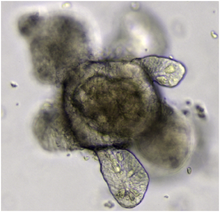Recombinant Human BMP-7 / OP-1: Scientific background and Collaboration Opportunity
Scientific background
Bone Morphogenetic protein 7 (BMP7), also known as osteogenic protein 1 (OP-1) is a multifunctional growth factor belonging to the transforming growth factor beta (TGFbeta) super-family. Initially discovered in 1965 by Marshall Urist, BMPs are the only known proteins capable of inducing the formation of new bone. BMPs act by binding to the cell’s exterior and signaling to the nucleus via intracellular proteins called SMADs, which in turn induce transcription of numerous osteogenic genes. Other than its function in bone formation, it has a role in cartilage growth and development, cell proliferation and apoptosis, organ regulation and repair, and many other bodily functions and processes. Here is a look at some of BMP7 possible therapeutic applications.
Therapeutic Potential: Bone and Cartilage
OP-1 Implants (OP-1 Putty) were approved by the FDA in 2001 for Stryker Corporation. This approval is under a humanitarian device exemption (HDE), which limits its use in the US to 4000 patients a year. OP-1 Implant is approved in 27 other countries as well. Belgium is one of the 28 countries that has approved using BMP7 for use in nonunion bone fractures. A study of the cases in Belgium from 2001 to 2006 (from the surgeons that responded) showed that treatment with BMP7 resulted in a clinical healing rate of 79.6% and a radiographic healing rate of 84.9%.1 Most of these cases possessed open fractures, infected wounds, or fractures with bone loss that had not responded to other treatments.
In a study of the overall success of OP-1 Putty, the results showed that the OP-1 Putty is at least comparable to an autograft control group for at least two years after surgery of patients with degenerative spondylolisthesis.2
BMP7 research is also occurring in cartilage repair. There has been encouraging work in repair of osteochondral defects using BMP7. BMP7 was used to augment the microfracture procedure and the two act synergistically to stimulate cartilage repair. Chodral defect repairs have also showed that BMP7 has cartilage repair capacity, including for months after BMP7 is cleared from the site of repair.3
Therapeutic Potential: Identifying Cancer
|
Cancer |
BMP7 Effect |
Results |
|
Colorectal |
BMP7 levels higher in cancer tissue than control tissue |
Elevated BMP7 levels correlated to depth of tumor invasion, liver metastasis, liver recurrence, and cancer-related death. BMP7 expression was an independent prognostic factor of overall survival and could be used as a clinical marker for colorectal cancer patients.4 |
|
Renal Clear Cell Carcinoma |
BMP7 antagonist SOSTDC1 is down regulated in RCC |
SOSTDC1 suppresses BMP7 induced phosphorylation of R-Smads-1, 5, 8 signaling. When SOSTDC1 is restored in RCC, RCC cell proliferation is suppressed.5 |
|
Breast |
BMP7 levels correlate to estrogen and progesterone receptor levels. |
BMP7 is highly correlated to both estrogen receptor levels and progesterone receptor levels. Both of these are important markers for breast cancer prognosis and therapy.6 |
Breast Cancer is an interesting case in that their have been studies that claim that BMP7 can promote or inhibit growth in breast cancer cells. One study that points towards the inhibitory effects of BMP7 claims that decreased BMP7 expression in primary breast cancer was associated with the formation of bone metastases. BMP7 also decreased the expression of vimentin in MDA-MB-231. Daily admission of BMP7 inhibited formation and progression of osteolytic bone metastases.7
Moreover, another paper has results that maintain that BMP6 and BMP7 have inhibitory effects on p38 signaling and steroid sulfatase expression, which were functionally involved in the suppression of estrogen induced mitosis of breast cancer cells.8
There is an additional study that gets mixed results. In four cancer cell lines that receive BMP7 treatment there is a reduction of cell growth. However, this study also gets opposite results. In one cell line BMP7 silencing resulted in growth inhibition via G1 arrest. In another cell line (MDA-MB-231) BMP7 treatment protected cells from apoptosis. Moreover, these cells had a 2.3 fold increase in cell migration and a 3.9 fold increase in cell invasion.9
One more paper looks at the role of BMP7 in p53-deficient cells. BMP7 can maintain cell survival in p53-deficient cells. Moreover, knockdown of BMP7 inhibited the proliferation of p53-deficient breast cancer cells as opposed to wild type p53.10
Therapeutic Potential: Treating Cancer
|
Cancer |
BMP7 Effect |
Results |
|
Cervical |
BMP7 inhibits telomerase activity |
Continuous application of recombinant human BMP7 lead to tumor growth arrest.11 |
|
Esophageal Carcinogenesis |
BMP7 reversed TGF-beta1 effects |
TGF-beta1 treated cells showed expression changes suggestive of EMT. However, addition of BMP7 reversed the TGF-beta1 induced changes.12 |
|
Hepatocellular Carcinoma |
BMP7 inhibited by over expression of GPC3 |
BMP7 and FGF2 are both inhibited by GPC3 that is over expressed in HCC cells.13 |
|
Prostate |
BMP7 expression inversely related to tumorigenic and metastatic potential |
BMP7 counteracts physiological epithelial-to-mesenchymal transition. It inhibited the growth of cancer cells in bone in nude mice, but had no significant inhibitory effect in intraprostatic xenografts. BMP7 can still counter the EMT process in metastatic tumor.14 |
|
Uveal Melanoma |
Low or not detectable BMP7 expression in tumor tissue |
Inoculation of nude mice with BMP7 expressing cells resulted in inhibited tumor progression. The decreased expression of BMP7 contributes to the progression of uveal melanoma.15 |
Therapeutic Potential: Other
|
Application |
BMP7 effect |
|
Kidney |
Renal BMP7 disappears early in fibrogenic renal diseases.16 However, addition of BMP7 to kidney decapsulated rats resulted in increased tubular regeneration in a dose dependent manner before significant fibrosis is established.17 |
|
Liver |
BMP7 has a role in liver organogenesis and development. Administering rhBMP7 results in enhanced liver regeneration.18 |
|
Brain |
BMP7 promotes neuroregeneration in stroke animals.19 |
|
Intestine |
rhBMP7 given to IBD in rats developed a much less severe form of colitis when the BMP7 was administered either 1.5 hour before or 24 hour after colitis induction. BMP7 plays a role in the regulation of anti-inflammatory response in the adult tissue.20 |
|
Diabetes |
BMP7 acts to prevent diabetic damage in the salivary gland and is correlated to the mRNA levels of BMP7 in the tissue.21 |
|
Asthma |
BMP7 ligand levels are the same a baseline, but allergen challenge was associated with sustained up regulation of BMP7 in airway epithelium and infiltrating inflammatory cells. BMP receptor expression is down regulated in the asthmatic airway. Allergen provocation increases expression of BMP7 ligand, which activates BMP signaling and increases receptor expression, which may contribute to control of inflammation.22 |
|
Adipose Tissue |
BMP7 promotes differentiation of brown pre-adipocyte even without the normally required hormonal cocktail. This could be a new method for treatment of obesity.23 |
|
Cardiovascular |
Active Vitamin D has been shown to increase the expression of BMP7 and MMP8, leading to a decrease in profibrotic signaling and collagen deposition, which decreases fibrosis.24 |
|
Parkinson’s Disease |
BMP7 pretreatment, as compared to the control, had a reduction in methamphetamine (MA) induced rotation and partially preserved KCl induced dopamine release and increased TH immunoreactivity. These results point to BMP7 having neuroprotective and/or neuroreparative effects against 6-OHDA lesioning in an animal model of Parkinson’s disease.25 |
|
Stem Cells |
BMP7, as opposed to BMP2 and BMP4, prevents the loss of primitive hematopoietic progenitor cells cultured in serum free medium with SF3.27 |
|
Fungiform Papillae |
In the stage after the pre-papilla placodes have formed (E14), exogenous BMP2, 4, and 7 each inhibits papilla formation in a linear pattern.28 |
|
Ankylosing Spondylitis (AS) |
There is overproduction of both BMP2 and BMP7 in AS patients. Moreover, serum BMP7 levels reflected the radiographic damage observed in AS.29 |
Collaboration Opportunity
SBH Sciences Recombinant human BMP-7 is a soluble 30 kDa (homodimeric glycoprotein consisting of two 139 amino acid residues) protein which corresponds to the amino acid residues 293 – 431 of the full-length BMP-7. The protein is produce by CHO cells and it is glycosylated. The In-Vitro activity of the recombinant protein is measured based on inducing alkaline phosphatase activity using the ATDC-5 cells. As reported by others, several different mature forms (N-termini starting at positions 293, 300, 315 and 316) have been identified by direct sequencing.
SBH Sciences is looking for partners to investigate SBH Sciences recombinant BMP-7 as therapeutic agent, as well as diagnostic tool.
We are open for suggestions and would be pleased to hear from you.
References:
1. Desmyter S et al, Acta Orthopaedica Belgica, 74(4) 534-7, Aug 2008
2. Vaccaro Ar et al, The Spine Journal, 8(3) 457-65, May-Jun 2008
3. Chubinskaya S et al, International Orthopaedics, 31(6) 773-81, Dec 2007
4. Motoyama K et al, Annals of Surgical Oncology, 15(5) 1530-7, May 2008
5. Blish KR et al, Molecular Biology of the Cell, 19(2) 457-64, Feb 2008
6. Schwalbe M et al, International Journal of Oncology, 23(1) 89-95, Jul 2003
7. Buijs JT et al, Cancer Research, 67(18) 8742-51, Sep15, 2007
8. Takahashi M et al, The Journal of Endocrinology, 199(3) 445-55, Dec 2008
9. Alarmo EL et al, Cancer Letters, Nov 2008
10. Yan W et al, Cancer Research, 67(19) 9117-24, Oct 1, 2007
11. Cassar L et al, Cancer Research, 68(22) 9157-66, Nov 15, 2008
12. Rees JR et al, Cancer Research, 66(19) 9583-90, Oct 1, 2006
13. Midorikawa Y et al, International Journal of Cancer, 103(4) 455-65, Feb 10, 2003
14. Buijs JT et al, The American Journal of Pathology, 171(3) 1047-57. Sep 2007
15. Notting I et al, Investigative Ophthalmology & Visual Science, 48(11) 4882-9, Nov 2007
16. Mitu G et al, Frontiers in Bioscience, 13 4726-39, May 2008
17. Dube PH et al, Toxicologic Pathology, 32(4) 285-92, Jul-Aug 2004
18. Sugimoto H et al, The FASEB Journal, 21(1) 256-64, Jan 2007
19. Chou J et al, Journal of the Neurological Sciences, 240(1-2) 21-9, Jan 15, 2006
20. Maric I et al, Journal of Cellular Physiology, 196(2) 258-64, Aug 2003
21. Izumi M et al, European Journal of Pharmacology, 596(1-3) 1-5, Oct 31, 2008
22. Kariyawasam HH et al, American Journal of Respiratory and Critical Care Medicine, 177(10) 1074-81, May 15, 2008
23. Tseng YH et al, Nature, 454(7207) 1000-4, Aug 21, 2008
24. Artaza J et al, The Journal of Endocrinology, 26, Nov 2008
25. Harvey BK et al, Brain Research, 1022(1-2) 88-95, Oct 2004
26. Chou J et al, Neuroscience, 151(1) 92-103, Jan 2008
27. Grassinger J et al, Cytokine, 40(3) 165-71, Dec 2007
28. Zhou Y et al, Developmental Biology, 297(1) 198-213, Sep 2006
29. Park MC et al, Scandinavian Journal of Rheumatology, 37(3) 200-4, May-Jun 2008




SHARE